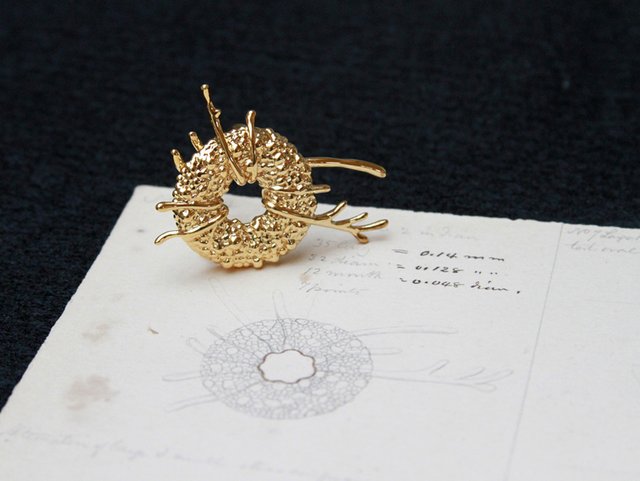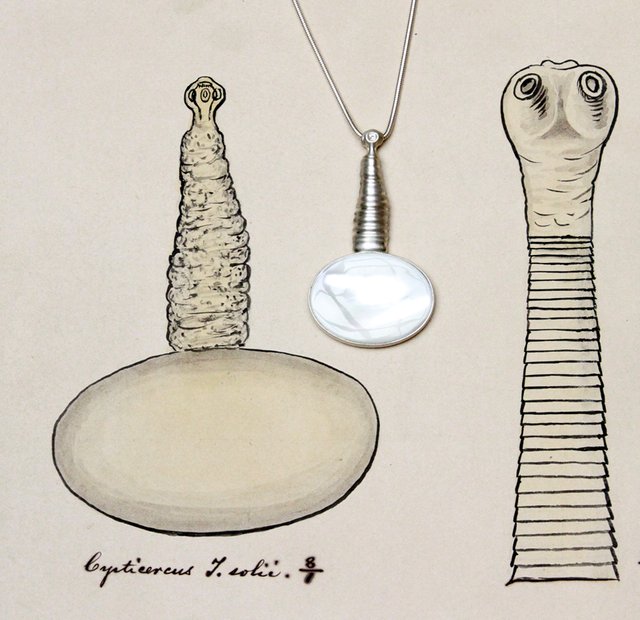Victorian Biology & Contemporary Jewelry
Can Victorian microbiology inspire beautiful jewelry?
The answer is yes!
Emily Cobb first visited the Wagner's museum over ten years ago and returned repeatedly finding inspiration in the displays of taxidermied animals. But it wasn’t until she was awarded a Temple University-Wagner Institute Fellowship that she took the opportunity to explore the materials in the Wagner's archives. She was particularly drawn to the collection of tiny detailed drawings of microscopic organisms and bacteria by the 19th-century biologist Joseph Leidy.

Drawings of microscopic organisms by Dr. Joseph Leidy.
From the Archives of the Wagner Free Institute of Science
Leidy’s scientific drawings reminded her of technical drawings created by designers, like René Lalique, for jewelers to interpret and recreate as three-dimensional objects made with precious metals and gems. This inspired her to interpret Leidy’s drawings through the mindset of a contemporary jeweler. In Emily’s words:
The world of science and art often overlap, and the process of creating detailed renderings in both the field of natural science and jewelry design is an inspirational example. Whether these drawings are ultimately presented to an audience in a lecture hall or to a jeweler in their studio, the goal is similar: to produce a drawing or diagram that will describe the particular qualities and characteristics of a specimen to an individual who cannot see the actual thing in front of them. Nevertheless, even extremely detailed scientific and artistic renderings are subject to individual interpretations.
Over the course of her fellowship, Emily studied hundreds of drawings from the Wagner's collection. She used a 3D modeling program to transform scans of Leidy's drawings from a single perspective into three-dimensional forms. In this program, she could move the forms around and get an idea of how they could interact with the body as jewelry. Then, using a combination of 3D printed materials, mild making, and traditional jewelry fabrication techniques, she created the following pieces. Each is pictured with the original drawing that inspired it.

Difflugia Pseudostome - Ring. Gold-plated Brass.
Difflugia is a genus of single-cell organisms.

Diplophrys Archeri 1414 and Diplophrys Archeri 1415 - Brooches. Gold-plated Brass, Lacquer.
Scientific description of Diplophrys archeri

Cysticercus T. Solii - Necklace. Sterling Silver, Mother of Pearl.
T. solium is a species of tapeworm!

Cysticercus T. Solii - Ring. Sterling Silver, Mother of Pearl.
T. solium is a species of tapeworm!
What do you think? Would you wear a tapeworm necklace? An Amoeba brooch?
What inspires you to create?
Let us know. We are always looking for new ways to engage people with historical resources!
A wonderful and particularly creative example of how the arts can intersect with scientific archival holdings. And Leidy's work is so wonderful. (I could just get lost in that!)
Also, readers might want to see the Friday Arts video about Emily Cobb's work by the public media organization in Philadelphia, WHYY: https://video.whyy.org/video/emily-cobb-poh3hb/
Thanks for posting the link to the video Ken! It gives you a much deeper look into Emily's process.
These really are so striking and beautiful. I take inspiration from Nature often and I love the idea of it on a microscopic level informing creation and colour and form.
Thank you for taking a look. I agree, there is so much inspiration to be found in the natural world. We often forget there is a huge part of it too small for our eyes to see. Lucky for us, Leidy and others took the time to document these beautiful microscopic organisms.